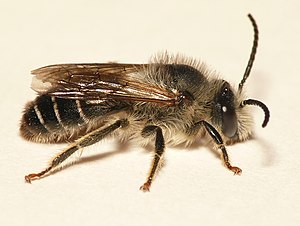Melitta leporina
| Melitta leporina | ||||||||||||
|---|---|---|---|---|---|---|---|---|---|---|---|---|

Melitta leporina |
||||||||||||
| Systematics | ||||||||||||
|
||||||||||||
| Scientific name | ||||||||||||
| Melitta leporina | ||||||||||||
| ( Panzer , 1799) |
Melitta leporina is a bee from the family of Melittidae .
features
The bees have a body length of 11 to 12 millimeters (females) or 10 to 11 millimeters (males). In the female, the head, the back of the thorax and the first tergite are yellow-brown, the ventral side of the body is hairy whitish. The mesonotum is provided with light hair, which is mixed with black hair. The second to fourth tergite is hairy black on the disc and has broad white bands that cover the end edge. The fifth and sixth tergite are black, but hairy white on the sides. The splint brush (Scopa) is yellowish. The antennae are light red-brown on the underside. The males are hairy yellow-gray, the ventral side of the head and thorax is whitish. The mesonotum is colored like in the female. The second to fifth tergite has protruding, white hair ties that cover the end edge. The discs of the third to seventh tergite are hairy black. The antenna elements are widened at an angle in the middle on the front. They are brownish in color on the underside. The sixth sternite is basal with a longitudinal keel, the eighth sternite is red-brown.
Occurrence and way of life
The species is distributed in southern and central Europe and Great Britain, east to the Caucasus. They colonize dry slopes and alfalfa fields . Pollen is distributed exclusively to papilionoid collected (Faboideae). The males always gather at the same plants to sleep in the evening. The animals fly from mid-June to late September. Nomada flavopicta is a cuckoo bee of the species.
supporting documents
Felix Amiet, M. Herrmann, A. Müller, R. Neumeyer: Fauna Helvetica 20: Apidae 5 . Center Suisse de Cartographie de la Faune, 2007, ISBN 978-2-88414-032-4 .